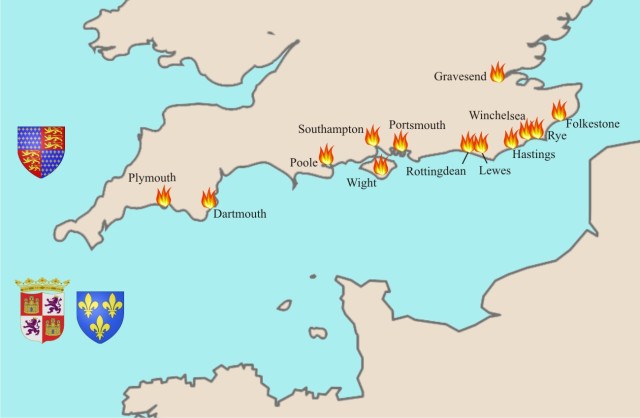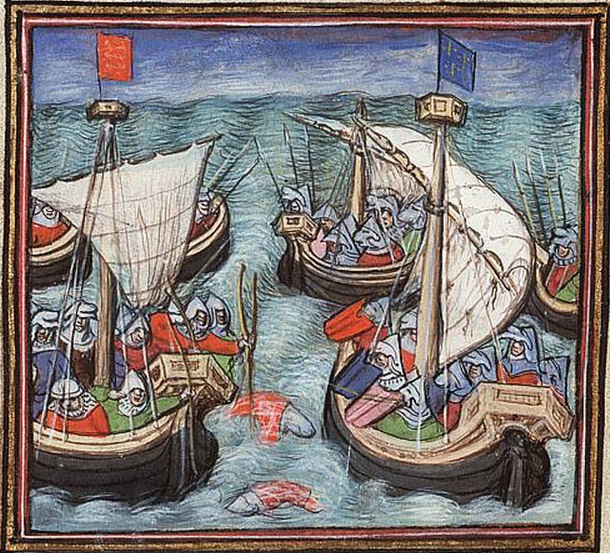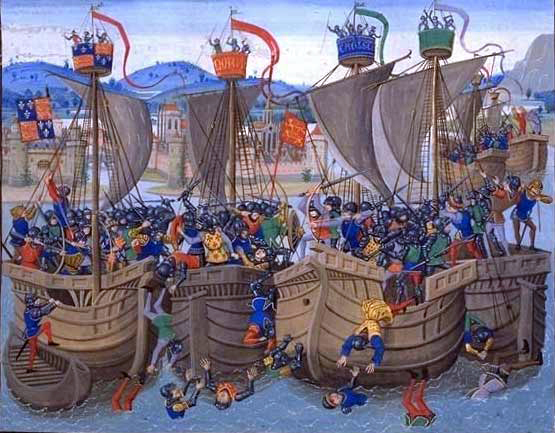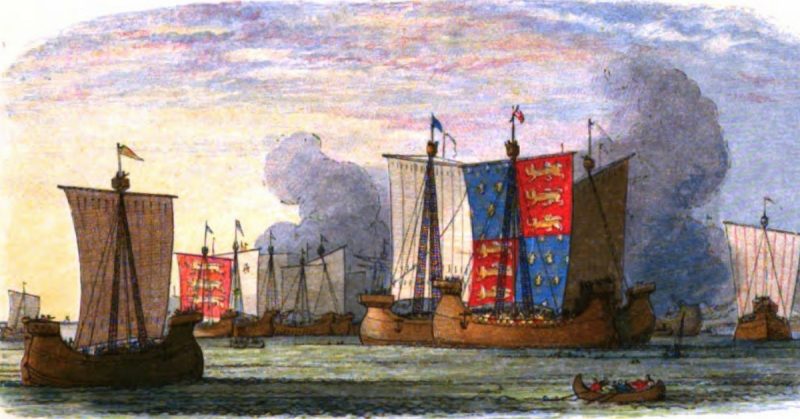War at sea in the Middle Ages could be a terrible business. Rather than a firefight between ships, it consisted of fierce boarding actions with little quarter given. The Hundred Years War (1337-1453) is mostly remembered for famous land battles such as Agincourt, but fighting at sea was also vital.
Why did the war at sea matter? What did each side hope to gain? And what made it such a brutal part of the war?
Supplies and Piracy – Why the War at Sea Mattered
At the start of the Hundred Years War, the King of England did not rule an island nation. Instead, he was the monarch of the remains of the Angevin Empire, which included England, Wales and swathes of modern France.
Trade was a vital part of the English economy, and a part that relied on sea travel to reach continental markets, where English merchants made their profits selling wool. Sea travel was also needed for the King to supply his continental territories, and to pursue a war fought on French soil.
On top of this, piracy was a problem for English traders. As well as pirates engaging in independent acts of robbery, there were those sponsored, officially or unofficially, by the French crown. The most infamous pirate of the 14th century, John Crabb, was captured five years before the war began. But his contemporaries continued to plague English shipping.
The English needed to control the seas if they were to maintain their trade and their empire, and to defeat pirates. The French sought to split that empire by smashing English fleets.

Aims of the Two Sides
From the start, France continued its policy of the previous hundred years, pushing out from Paris to control more and more of the coast. Certain towns were particularly important – the shipyards at Rouen and Harfleur, the naval base at La Rochelle, the key port of Calais.
But control of the coastal region in general was important, as this was where sailors were recruited from. Control of coastlines gave each side the human resources to control those coastlines – a virtual cycle for the leaders involved.

The capture of the same objectives shaped English thinking and the way they fought at sea. But while the French were often in the defensive position on land, England, as the power more reliant on the seas, was put on the defensive there. Merchants, supply lines and fishing fleets all had to be defended.
The Fleets
The groundwork for fleets was laid in the years before the war. Phillip IV of France, seeing the need for war against the English at sea, built dockyards at Rouen. Edward II of England, a king generally remembered for his failings, added to his father’s collection of galleys with more royal ships.
Despite this, neither side had a substantial fleet at the start of the war. Their solution to the shortage of ships was to take them from civilians.
The requisitioning of civilian ships was not popular. Owners were not compensated for the opportunities lost while they lacked their ships. They were not repaid if the vessel was damaged or lost. Modifications, such as the addition of fore and aft castles, might leave the ship unsuitable for its original work.

Much of the English fleet was made up of cogs – high-sided ships well suited to transporting men and provisions across the seas. The French placed more emphasis on galleys, flat-bottomed boats that often had oars as well as sails. Thanks to their lack of keels, galleys could be used close in to land. They were ideal for intercepting enemy vessels, making them useful for attacking the more cumbersome supply cogs.
The aristocracy were trained for war on land, not at sea, and they had far less attachment to naval engagements. This is reflected in the low priority these fights were given in the chronicles of the time. This shifted a little in England under King Henry V, who recognized the importance of the fleet and sought to bolster it. But his early death returned naval warfare to the bottom of the priority pile.
The Horrors of Combat

Fighting on ships was like fighting on land, except messier, more brutal, and with little prospect of retreat.
Cannons were not yet a significant part of naval warfare, and so almost everything came down to boarding actions. Each side would maneuver to try to gain the advantage, bringing more of their ships to bear up close, and it was this that brought English victory at Sluys in 1340, the first major battle of the war.
Sluys also demonstrated the importance of archers at sea. They could rain down fire upon the enemy decks, softening up opposing crews before the ships came close.
It was when the ships were side by side, lashed together to allow borders to cross, that the real action began. Using the same weapons and armor they fought with on land, men hacked at each other in the cramped confines of ships’ decks. Armored men fell overboard and drowned. Unable to run away, the losers were often cornered and forced to fight to the last man.
With their blood up, the victors could be merciless. At the Battle of Winchelsea in 1350, the English threw captured French soldiers and sailors overboard. Many of these men would have been wearing armor. Many could not swim even in the best of circumstances. Drowning was almost certain.
The results were often very one-sided. At La Rochelle in 1372, the Castillians killed or captured thousands of Englishmen and destroyed almost their entire fleet in return for only minor losses.
War at sea was brutal and often ignored by those on shore, but it was vital to the fighting of the Hundred Years War.
Sources:
- Christopher Allmand (1989), The Hundred Years War: England and France at War c.1300 – c.1450.
- Ian Mortimer (2008), The Time Traveller’s Guide to Medieval England.
